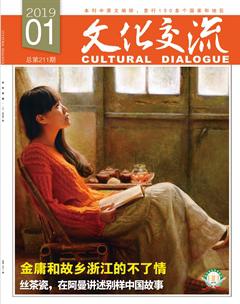Show in Oman Showcases China’s Ties with World
Yu Jiji
The Fourth Meeting of the UNESCO Silk Roads Online Platform International Network was held in Muscat, Sultanate of Oman, from 28 - 31 October 2018. Present at the meeting were about 80 representatives and dignitaries from the 17 states connected with Silk Roads including government officials, experts and scholars of cultural heritage.
In conjunction with the meeting, the “Exhibition of Chinese Silk, Porcelain and Tea” was officially inaugurated on 29 October, with the Peoples Republic of China serving as the Guest of Honor.
Zhao Feng, director of China National Silk Museum based in Hangzhou, is the producer of the exhibition. It was the first time that he masterminded such an exhibition with exhibits from three different institutions. The three partners are China National Silk Museum, China National Tea Museum (also based in Hangzhou) and Longquan Government. Longquan is where celadon originated and is now flourishing after a long and slow comeback as of the 1950s.
The exhibition at the Oman National Museum highlighted a multicultural dialogue among the Silk Roads states. Altogether there are 86 pieces/sets of silk, tea and porcelain, largely created by artists of today. The exhibition presented five sections with respective focuses on history, trade routes, cultural exchanges, traditional and modern techniques, and fusion of today.
Also on display at the exhibition was a World Map of Cultural Exchanges, graphically illustrating a history of looms across the world. Based on another map originally developed by China National Silk Museum, the new map was developed through worldwide interactions with scholars and fans. It graphically enabled visitors to access knowledge of looms, silk and tea and the contributions these objects have made to the world.

展覽现场Two views of “Exhibition of Chinese Silk, Porcelain and Tea” at the Oman National Museum in Muscat,Sultanate of Oman

The curtains descended on the exhibition the Oman National Museum in Muscat, Sultanate of Oman on November 12. Right now, the exhibition is on in Dubai, United Arab Emirates. The same exhibition can now be accessed at the website of China National Silk Museum.
Lou Hangyan, vice director of the Public Education Department of China National Silk Museum, was in charge of arranging the exhibits at the Oman National Museum in Muscat, Sultanate of Oman. Lou and her colleagues arrived with nine large boxes of exhibits and shelves. They worked hard arranging the exhibits in an exhibition hall of 400 square meters within four days.
Fortunately, they had had already figured out a suitable overall arrangement for the exhibition long before they arrived with the huge boxes.
Long before the exhibition in Muscat, all the exhibits were ready. Zhao Feng and Lou Hangyan coordinated the efforts of the three partners. All the texts and exhibits came together and experts went through a procedure to make the exhibition an organic whole. Zhao and Lou even traveled all the way from Hangzhou to Longquan to select appropriate porcelain items. Secondly, as they did not have time to do a field study in Oman the arrangement of the exhibition, they figured out the overall arrangement on the basis on the floor plan and photos of the exhibition hall sent over in emails from Muscat.
Another difficulty conquered in the preparatory work for the exhibition was translation.
For the success of the exhibition, China National Silk Museum communicated thoroughly with the Oman National Museum. The communication was time-consuming and challenging: a Chinese message was first translated into English, and then the English translation was translated into Arabian. If a detail needed further clarification, there would be more rounds of three-way translation. The editing and layout of the bilingual information such as captions and short essays for the exhibition were finalized through many more rounds of discussions.
Zhao Feng served as a narrator for visitors on the launching day of the exhibition. He had done a thorough homework for the narration. In order to familiarize himself with tea and porcelain, he visited China National Tea Museum and Southern Song Guan Kiln Museum and listened to the English narrations.

